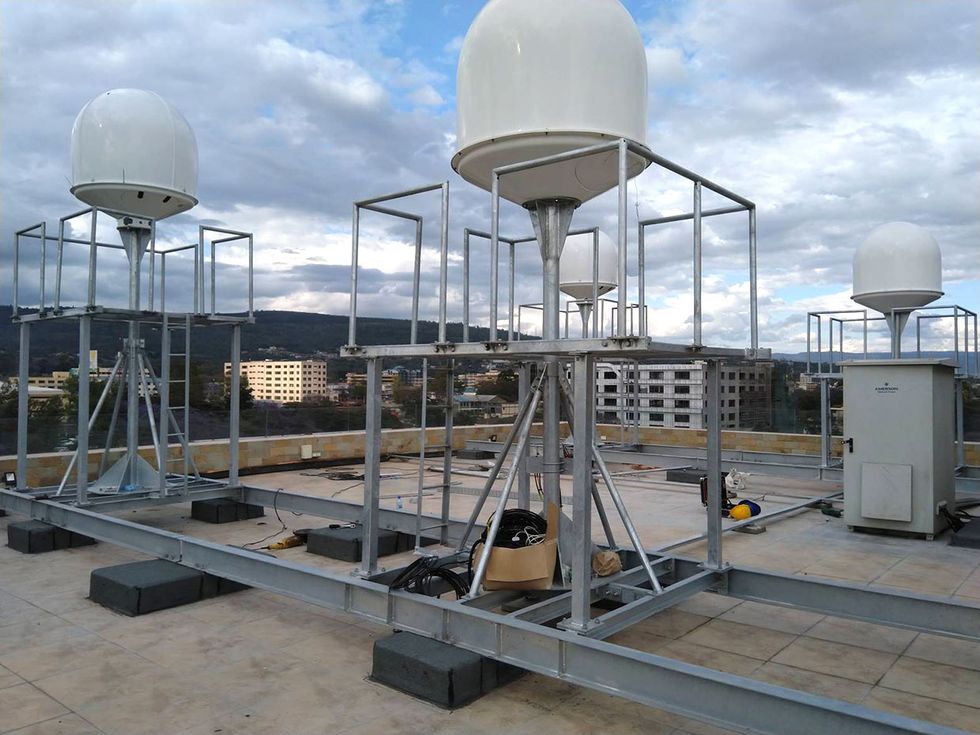Loon’s Balloons Will Fly Over Kenya in First Commercial Telecom Tryout
Floating equipment in the stratosphere prevents the need for extensive infrastructure on the ground

Kenya runs on mobile phones. There are almost 43 million in use by Kenya’s nearly 50 million citizens, meaning the East African country has the 33rd highest mobile phone usage in the world. By comparison, it has fewer than 70,000 fixed landlines.
And yet, outside of major cities like Nairobi, the infrastructure for mobile telephony is lacking. That’s why, in 2019, telecommunications provider Telkom Kenya will begin turning to high-altitude balloons built by the Alphabet subsidiary Loon to provide mobile phone service.
“High-altitude balloons are actually a very reasonable way to approach this problem,” says Sal Candido, Loon’s head of engineering. “They’re high, they cover a lot of ground, and there are no obstacles.” It’s simple “but for one thing,” Candido adds—each balloon needs to stay in place in the stratosphere, providing coverage for one area for hundreds of days before being replaced.
Candido has been with Loon for five years, long before the effort—then known as Project Loon—graduated from X, the Alphabet research and development subsidiary, in July 2018. Candido initially worked on developing the balloons’ navigation system, one of the key components needed to address the “one thing” keeping the idea from really lifting off.
The challenge of how to navigate the balloons properly has changed drastically during Candido’s time at Loon, because over the years the understanding of how Loon would operate has changed drastically as well.
“Pretty early on,” Candido says, “we had a much different concept of how Loon would work. The idea is that we would launch a lot of balloons and they would circle the globe like leaves on a river, going where the river takes them.” The engineers imagined that after circling the planet, the balloons would be in roughly the same spot in which they began their journey. This would allow the balloons to circle the globe in a long line, with balloons replacing one another overhead to provide coverage.
As Loon launched more balloons for its test flights—the company has now logged over 30 million kilometers—the engineering team realized that they could control where the balloons would travel. “Sometimes the most obvious answer comes to you much later on,” Candido says. “Why don’t the balloons just not leave the coverage area?” It turns out that this is possible, at least in most places, for reasonable durations.
“I think the good thing for Loon’s project is that they’re staying near the tropics,” says George Modica, a consulting meteorologist with Atmospheric and Environmental Research, in Lexington, Mass. Modica says there are two things that could overwhelm a balloon’s navigation: the high-latitude meteorological phenomenon called the polar vortex, or the stratospheric effects of winds when they pass over a large mountain range. Lucky for Loon, Kenya experiences neither.
Each Loon balloon is actually two balloons in one. There is an outer balloon filled with helium to give the whole thing the lift it needs. That surrounds an inner balloon that’s filled with air, which can be pumped up or vented. When the inner balloon is inflated, the helium in the outer balloon is squeezed to a higher density, reducing lift. By this means, Loon’s engineers can control the balloon’s altitude to take advantage of different winds at different altitudes, allowing it to travel where it needs to go.

The engineers have gotten good at navigating this system—they can now hit their final destinations from thousands of miles away. In one series of tests, they were able to launch balloons from New Zealand and navigate them so precisely that they could provide cell service to target areas in Argentina and Australia. In fact, the balloons that will ultimately provide cell service across Kenya will be launched from Puerto Rico and travel across the Atlantic to their final destinations.
“It does seem a little strange, sending the balloons from Puerto Rico to Kenya,” says Modica. “But it’s really no different than navigating to stay in the same position.” In either case, the same principle applies: raising or lowering the balloon’s altitude to catch the wind it needs.
Navigating the balloons wasn’t the only challenge Loon tackled to make the whole system work. When your phone connects to a traditional terrestrial cell tower, it’s fairly straightforward. After all, the cell tower isn’t moving.
Not so with balloons, which are constantly drifting around on stratospheric winds. “The thing that is unique is that all our network nodes are constantly moving,” says Candido. Loon’s engineers developed ways the network could keep up with its constant changes of configuration so as to keep the data moving .
The balloons transmit data between them using point-to-point millimeter-wave communications. Each Loon balloon carries a triangular gondola made of carbon composites and containing—in addition to all the communications equipment it needs to provide LTE coverage for an area—three millimeter-wave radios on gimbals, each roughly the size of a beach ball. The gimbals give the millimeter-wave radios the flexibility to maintain a direct high-bandwidth connection to the nearest balloons in the network. As a result, the balloon network doesn’t need extensive infrastructure on the ground to work.

When Loon deployed balloons over Puerto Rico in 2017 in the aftermath of Hurricane Maria, each balloon was connected to its own ground station. That approach worked well for the island, according to Candido, but Puerto Rico is much smaller than Kenya. If you’re already putting in ground stations to pair with each balloon over a large area, he points out, you might as well skip the balloons and invest entirely in ground-based infrastructure.
That’s why, in September 2018, it was a big deal when Loon announced that it had successfully bounced data roughly 1,000 kilometers across a line of seven balloons over California. The achievement will allow ground stations in cities to send data up to balloons overhead, which will relay signals to other balloons farther away. To realize this goal in Kenya, Loon has already begun constructing ground stations in Nairobi and Nakuru.
Loon plans to spend the first half of 2019 testing things, before Telkom Kenya begins using the balloon-based network to provide mobile phone service to the country’s rural millions. This first permanent deployment should convince any skeptics that the approach isn’t so loony after all.
This article appears in the January 2019 print issue as “Phone Service by Balloon.”